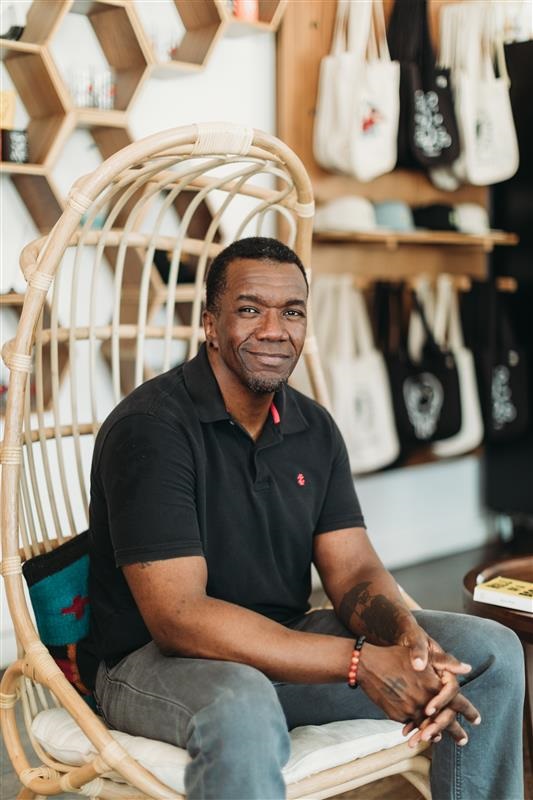the earthquake room opens with a mouth: a particular mouth, belonging to k, which has transmitted an infection to a particular perineum, belonging to bea, which has blossomed with a red and waxy sore that looks, depending who you ask, like an asshole, or like a barnacle, or like a mouth itself.
The novel—Davey Davis’s debut, and the first work of fiction from TigerBee Press—is the story of k and bea, young and queer and in love in a barely-near-future Oakland. That we begin to know them through an unintentional act of biological communication is significant, because at its core, this is a book about the ways in which even our most intimate relationships can slip beyond our control, fracturing along barely perceptible fault lines.
k and bea are on unsteady ground even before the herpes incident, and I mean this literally: the Bay Area Davis imagines is one where the earth shakes underfoot every few moments, unexplained accidents are frequent occurrences, and residents receive regular Seismic Updates. Meanwhile, a deeply familiar but unidentified POTUS dismisses the impending superquake as “a media distraction.” Coffee is quickly going extinct, and companies are scrambling to capitalize on end-times anxiety (“COUNTING DOWN TO THE BIG ONE? JOIN FUTURBANK AND COUNT YOUR SAVINGS, TOO!”). It’s a slightly underdeveloped doomsday anticipation scenario, but one with the right emotional pitch: a persistent low-grade anxiety that thrums just beneath the surface, waiting for any chance to spew up into panic.
Against a backdrop of looming disaster, bea and k (and the novel itself) take shelter in the necessary realities of everyday life. Money must still be made; relationships must still be nurtured. The pair and their friends—central among them Claire, a hetero cosmetologist and photographer who’s close with bea, and Glory, a trans woman k has known for years—care for each other with tender resilience. They live in apartments strewn with crystals and cats and roommates, sew #BlackLivesMatter patches onto their jackets and hang PROTECT TRANS YOUTH posters on their walls. k crisscrosses the city as a bike messenger, and bea works at a mid-size nonprofit, spending her days watching “climate slums transition into refugee camps before becoming prisons that eventually stop appearing on Google maps.” Most importantly, they try to find sanctuary in their own queer love. “what was it that Frank Ocean said when he came out,” the narrator muses, “something about falling from a plane? that’s what it felt like to bea, too: a drop from a great height, down to where there was atmosphere, where you could finally, for the first time, breathe. who needs heights? the depths are where life is. the great rifts at the bottom of the ocean where things live, grow, glow, are hidden away only in the sense that those above are unaware of their existence.”
k and bea have reached these depths from very different places. bea is a once-straight, typically monogamous cis woman; she is rational and honest and ordered, a planner. k is a poly sometimes-hustler who, after living for a while as a trans man, has “retreated back into her original gender, a version blurred by neglect.” She is fiercely independent and “too much” for any category or constraint, too much to be contained. Nevertheless, they carve out a home in the quiet depths together, their unlikely commitment like a bulwark against the equally unlikely future of their world.
But, as k comes to know through endless pad thai and weed deliveries, only those living highest in the high-rises are immune to the tremors below. Even as k and bea’s intimate world is being introduced, its foundations are shaking. The outside intrudes: headlines pierce the narrative at random intervals (“NO CHARGES FOR OFFICERS WHO FIRED INTO CROWD OF PROTESTERS”), and Davis peppers the text with associative interjections—“her mouth infected bea’s body (boba gleaming in an empty cup)”—that mimic the aesthetic experience of being permanently, constantly logged on, subject to pop-ups and push notifications and jarring conjugations of imagery and text. Information is unavoidable, but it’s not the only thing that finds its way in; the structures of power and violence that uphold the hetero status quo do too, and that’s when things begin to crumble.
The herpes that blooms on bea’s perineum heals fairly quickly. She takes a pill, applies an ointment, reassures k that “it isn’t your fault, it’s nobody’s fault,” and moves on. But for k, the implications of the transmission are devastating. Her guilt is agonizing as she considers the history of bea’s body, and all the bodies that have collided with it:
a lifetime of bruises, of men unaware of their own shapes, of street harassers and queer bashers and shitty dads and boyfriends and bosses—how could bea have escaped unscathed? (the answer: she couldn’t. she hadn’t.).
bea is the opposite of unscathed, in fact. Having been serially abused by an uncle who lived with her mother, she privately worries about “the possibility that she had not been born queer… but had been made that way (damaged goods), a side effect of patriarchy.” She expects—she needs—her queer love to heal, to reorder something knocked out of place; unlike the permanent discord between her and men, she expects her and k’s “language… to be identical, their communication perfect.” But k, in her guilt, suddenly finds herself on the wrong side of the divide: “now that she has hurt bea, how is she any better than the men that preceded her? how is her body, and its repercussions, any different from theirs?”
the earthquake room is a deeply psychological book, attuned to the disturbances of its characters’ mental landscapes to the point of feeling occasionally clinical. Davis’s ability to trace the reverberations of psychic damage through to the body, and into its encounters with other bodies, is especially remarkable, and especially visible through k. Obsessed with a need for atonement, she posts a Craigslist ad requesting the infection of her own perineum. She withdraws from bea and stops sleeping; her body and its desires spin out of control, resulting in a dysphoria that consumes her from the inside out. A nightmarish vision: her body “outstretched and transparent, Vitruvian, Mendietan, empty as a hot-water bottle, legs spread. a hand (whose?) lifts a lit match up through the thighs, and now the inside is illuminated like a cave without a wall painting. it’s empty, no rot to be seen, but nothing that grows, either.” Desperate to regain the contours of herself, she seeks collision with others (a tectonic plate), fucking a nameless woman in the pantry at a party and agreeing to meet a shadowy man who promises to give her herpes. Meanwhile, bea unravels too; left to her own devices, she compulsively binge-watches earthquake videos, unable to stop picking at the raw wound of anticipation.
These deteriorations—of psyche, relationship, and environment—feel like relief for k and bea, in the particular way that the manifestations of our fears often do. Anyone who worries knows that there’s some comfort in a well-worn anxiety, which is fundamentally an emotional rehearsal of the worst we suspect will come; the real fear is to be caught off guard, to be confronted with an unmediated disaster and an unrecognizable self. Better maybe to cling to the scraps of our agency, to materialize our crises ourselves, according to our natures. And so bea’s videos multiply in front of her paralyzed gaze, and k fuels her recklessness with “the excitement she feels, knowing how close she is to complete unhappiness (if bea leaves me), that darkness its own promise of relief.”
bea does leave: she packs a bag and boards a train heading inland, away from the San Andreas fault. At the same time, an elevator carries k high into an apartment building, where her Craigslist connection waits to meet and infect her. The low-grade anxious fever that underpins the whole narrative tightens into panic as bea’s trip stalls out following a Seismic Update, and the herpes-giver stalls ominously in his apartment, refusing to give k what she wants. As bea decides to turn around, k’s world turns upside down: violent tremors wrench the room into chaos, and she runs for her life.
It both is and isn’t the Big One. Down at street-level again, k quickly realizes that the event hasn’t been real for anyone else. But that doesn’t mean it hasn’t happened. Earlier in the novel, a blearily high Glory declares that “the stuff that scares you the most has already happened to you.” In a certain sense, she’s right. k and bea’s actions are both last-ditch attempts to restore equilibrium by participating in, and therefore maintaining, an ostensibly ‘natural’ systemic order. bea attempts to return to her hometown and therefore to her past (geologically safe, but otherwise the opposite), and k positions herself as female in a heterosexual encounter, inviting a gendered violence—even if only the violent structure of gender—onto herself. The symbolic disaster these actions call into being is a reminder that these structures foreclose the possibility of queer futurity altogether. The disaster has already happened, is always happening. As Davis frankly points out, queers can only ever prove that their lives and loves are real “by existing, by surviving, as well as by dying at the hands of straight people.”
the earthquake room can be read an exercise in entropy, a simulation of the inevitable disordering toward which our human systems tend. But the novel’s fundamental accomplishment, and its fundamental queerness, lies in its recognition that entropy is not necessarily degenerative. It can also be the opposite, creating the space for alternatives and for opportunities to rebuild. Queerness itself, after all, is entropic—the disorder in the system, the defiance of systemic containment in favor of multiplicity and unpredictability. It has never had a future, and won’t until the existing order has turned itself into rubble. k and bea’s world may be breaking down, but that’s never not been true—and what they choose to build in the ruins is what really matters. “the world may have ended, but this isn’t the end,” writes Davis, as their characters look out over the ocean. “out there is space for everything.”
The novel ends by reuniting k and bea, who will have to decide whether and how to rebuild. The key, again, can be found in Glory’s stoned wisdom from a few pages back: “when i think about the future, i think about the people i care about,” she says. “they’re both the same thing.” These words echoed through a recent conversation I had with a close friend, a Californian transplant whose father phoned to tell him about the apocalyptic bug-out bags he’s been buying for their family members. “All I could think about was how I don’t have a bug-out bag, I don’t have a plan,” my friend told me. “But… I know almost every queer person in Brooklyn. If the world ends, I’ll know everyone I need to know—because I know all the witches in Brooklyn.” Survival wears many different guises. It all depends, in the end, on what kind of world is worth surviving for.




